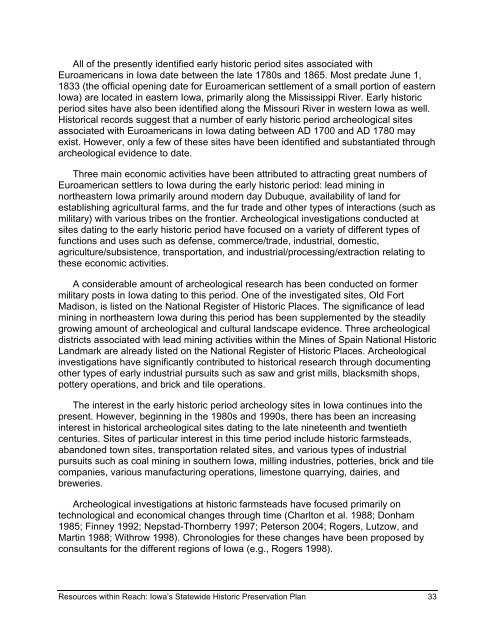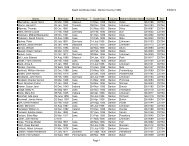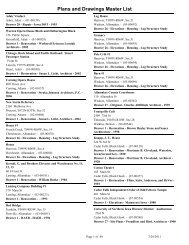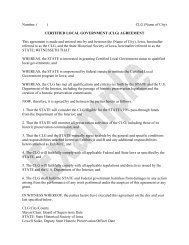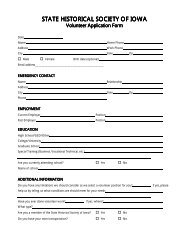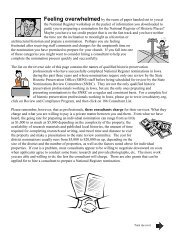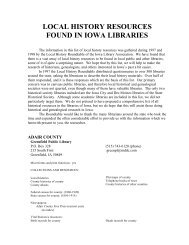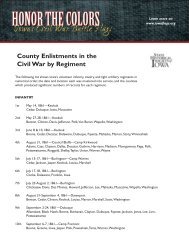vessels. Based on archeological, ethnohistorical, and linguistic evidence, it is believedthat historical American Indian Tribes such as the <strong>Iowa</strong>y, Oto-Missouria, and Ho-Chunk/Winnebago are descendants <strong>of</strong> the Oneota Culture.Historic Archeology <strong>Resources</strong>:Historic archeology has contributed significantly to understanding the history <strong>of</strong> <strong>Iowa</strong>.An extremely rich historical archeological record <strong>of</strong> <strong>Iowa</strong> sites dating from theseventeenth to the twentieth centuries have been identified, investigated, anddocumented. These sites are associated with different ethnic groups and functionaluses. Types <strong>of</strong> sites represented in <strong>Iowa</strong> include American Indian villages, fur tradeoutposts, frontier military posts, steamboat wrecks, coal and lead mining operations,limestone quarrying operations, breweries, saw and grist mills, historic farmsteads, andabandoned towns, just to mention a few. A number <strong>of</strong> these types <strong>of</strong> sites are extremelyinteresting because tangible evidence <strong>of</strong> the interactions between different historicethnic groups has been documented. Historic archeological sites have beeninvestigated in <strong>Iowa</strong> since the 1930s.The initial interest in early historic period sites focused on the early Euroamericansettlement <strong>of</strong> <strong>Iowa</strong> and on the interactions between American Indian tribes and theEuroamericans. In <strong>Iowa</strong>, the early historic period has been defined as the period <strong>of</strong> timefrom AD 1650 to AD 1865 in past planning efforts and developed historic contexts.Generally in <strong>Iowa</strong>, the year AD 1650 serves as a boundary between the historic andprehistoric periods. It is entirely possible that early historic Euroamerican period sitesdating before AD 1650 could exist in <strong>Iowa</strong>, although none have been documented todate.The interest in Early Historic American Indian sites was a logical extension <strong>of</strong> thearcheological focus on American Indian sites during the late nineteenth century andmost <strong>of</strong> the twentieth century. Early Historic American Indian sites associated with anumber <strong>of</strong> tribes such as the <strong>Iowa</strong>y, Winnebago, Sauk, Meskwaki, Yankton Sioux, andPottawattamie have been documented in <strong>Iowa</strong>. Most <strong>of</strong> these sites date to theeighteenth and nineteenth centuries. However, some <strong>of</strong> the identified sites date back tothe seventeenth century. Archeological investigations in northeast <strong>Iowa</strong> identified anumber <strong>of</strong> Oneota archeological sites dating to the seventeenth century that appear tocorrespond with historically reported locations <strong>of</strong> <strong>Iowa</strong>y villages during this time period(Mott 1938; Wedel 1959). Another site where numerous archeological investigationshave been conducted is Blood Run, a large Oneota site in northwestern <strong>Iowa</strong> andsoutheastern South Dakota (Henning and Theissen 2004). This site is listed on theNational Register <strong>of</strong> Historic Places and has been designated as a National HistoricLandmark. Historic accounts identify Blood Run as the location where a number <strong>of</strong>tribes including the Omaha, <strong>Iowa</strong>y, and possibly Oto lived together in the lateseventeenth century. The research and investigations conducted by Mildred Mott Wedelin northeastern <strong>Iowa</strong> was very significant as it represents one <strong>of</strong> the first attempts in theMidwest to correlate ethnographically known tribal groups with an archeologicallydefined prehistoric culture.<strong>Resources</strong> <strong>within</strong> <strong>Reach</strong>: <strong>Iowa</strong>’s <strong>State</strong>wide Historic Preservation Plan 32
All <strong>of</strong> the presently identified early historic period sites associated withEuroamericans in <strong>Iowa</strong> date between the late 1780s and 1865. Most predate June 1,1833 (the <strong>of</strong>ficial opening date for Euroamerican settlement <strong>of</strong> a small portion <strong>of</strong> eastern<strong>Iowa</strong>) are located in eastern <strong>Iowa</strong>, primarily along the Mississippi River. Early historicperiod sites have also been identified along the Missouri River in western <strong>Iowa</strong> as well.<strong>Historical</strong> records suggest that a number <strong>of</strong> early historic period archeological sitesassociated with Euroamericans in <strong>Iowa</strong> dating between AD 1700 and AD 1780 mayexist. However, only a few <strong>of</strong> these sites have been identified and substantiated througharcheological evidence to date.Three main economic activities have been attributed to attracting great numbers <strong>of</strong>Euroamerican settlers to <strong>Iowa</strong> during the early historic period: lead mining innortheastern <strong>Iowa</strong> primarily around modern day Dubuque, availability <strong>of</strong> land forestablishing agricultural farms, and the fur trade and other types <strong>of</strong> interactions (such asmilitary) with various tribes on the frontier. Archeological investigations conducted atsites dating to the early historic period have focused on a variety <strong>of</strong> different types <strong>of</strong>functions and uses such as defense, commerce/trade, industrial, domestic,agriculture/subsistence, transportation, and industrial/processing/extraction relating tothese economic activities.A considerable amount <strong>of</strong> archeological research has been conducted on formermilitary posts in <strong>Iowa</strong> dating to this period. One <strong>of</strong> the investigated sites, Old FortMadison, is listed on the National Register <strong>of</strong> Historic Places. The significance <strong>of</strong> leadmining in northeastern <strong>Iowa</strong> during this period has been supplemented by the steadilygrowing amount <strong>of</strong> archeological and cultural landscape evidence. Three archeologicaldistricts associated with lead mining activities <strong>within</strong> the Mines <strong>of</strong> Spain National HistoricLandmark are already listed on the National Register <strong>of</strong> Historic Places. Archeologicalinvestigations have significantly contributed to historical research through documentingother types <strong>of</strong> early industrial pursuits such as saw and grist mills, blacksmith shops,pottery operations, and brick and tile operations.The interest in the early historic period archeology sites in <strong>Iowa</strong> continues into thepresent. However, beginning in the 1980s and 1990s, there has been an increasinginterest in historical archeological sites dating to the late nineteenth and twentiethcenturies. Sites <strong>of</strong> particular interest in this time period include historic farmsteads,abandoned town sites, transportation related sites, and various types <strong>of</strong> industrialpursuits such as coal mining in southern <strong>Iowa</strong>, milling industries, potteries, brick and tilecompanies, various manufacturing operations, limestone quarrying, dairies, andbreweries.Archeological investigations at historic farmsteads have focused primarily ontechnological and economical changes through time (Charlton et al. 1988; Donham1985; Finney 1992; Nepstad-Thornberry 1997; Peterson 2004; Rogers, Lutzow, andMartin 1988; Withrow 1998). Chronologies for these changes have been proposed byconsultants for the different regions <strong>of</strong> <strong>Iowa</strong> (e.g., Rogers 1998).<strong>Resources</strong> <strong>within</strong> <strong>Reach</strong>: <strong>Iowa</strong>’s <strong>State</strong>wide Historic Preservation Plan 33
- Page 1 and 2: Resources within ReachIowa’s Stat
- Page 3 and 4: THE PLANNING PROCESSLet us begin by
- Page 5 and 6: Out of the 2001 cultural caucus sta
- Page 7 and 8: • Develop comprehensive and excit
- Page 9 and 10: the commission will become a more a
- Page 11 and 12: of archeological resources and Iowa
- Page 14 and 15: concentrations of bungalow houses.
- Page 16 and 17: The second state grant incentive, a
- Page 18 and 19: PRESERVATION PARTNERSInterested in
- Page 20 and 21: Iowa Barn Foundation. Founded in 19
- Page 22 and 23: appreciation for historic propertie
- Page 24 and 25: AMERICAN INDIAN TRIBESThere is curr
- Page 26 and 27: settlements. Many of Iowa’s curre
- Page 28 and 29: onslaught of Euroamerican speculato
- Page 30 and 31: 1988—Appendix A, no. 2). It addre
- Page 32 and 33: (13CK405), Allen Fan Site (13HA382)
- Page 36 and 37: Historical archeological investigat
- Page 38 and 39: ecame both catalyst and arbiter of
- Page 40 and 41: In Iowa the best known route to tra
- Page 42 and 43: element from Ireland. Over the next
- Page 44 and 45: flood events that occurred in Iowa
- Page 46 and 47: National Register of Historic Place
- Page 48 and 49: Four archeological sites and two ar
- Page 51 and 52: ased on available funding and confl
- Page 53 and 54: Understandably then, community advo
- Page 55 and 56: Objective 1-CExpand public apprecia
- Page 57 and 58: Objective 2-HPursue adoption of an
- Page 59 and 60: Objective 4-JDevelop communication
- Page 61 and 62: BIBLIOGRAPHYGeneral WorksAlex, Lynn
- Page 63 and 64: Gilder, Robert F. “Prehistoric Vi
- Page 65 and 66: Sissel, Dewey Kent. “The Octagon
- Page 67 and 68: 17. Parrott, Charles. “An Archite
- Page 69 and 70: 47. Naumann, Molly Myers. “Archit
- Page 71 and 72: 77. Jacobsen, James E. “Capitol E
- Page 73 and 74: • Indian Contact, Conflict, and D
- Page 75 and 76: • Labor Movements and Organizatio
- Page 77 and 78: APPENDIX C: IOWA CITIES AND COUNTIE
- Page 79 and 80: APPENDIX E: SIGNIFICANT HISTORICPRE
- Page 81: 2005A promotional program for Iowa


